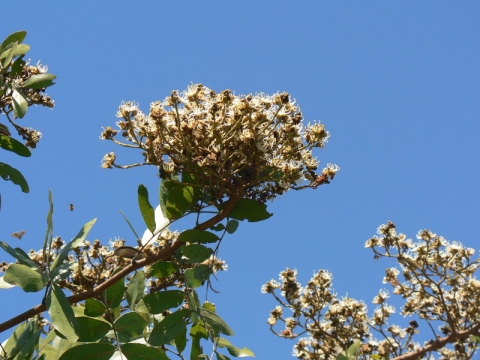Julbernardia paniculata
(Benth.) Troupin
Fabaceae
Berlinia baumii Harms
Berlinia paniculata Benth.
Isoberlinia baumii (Harms) P.A.Duvign.
Isoberlinia paniculata (Benth.) Hutch. ex Greenway
Julbernardia baumii (Harms) Troupin
Pseudoberlinia baumii (Harms) P.A.Duvign.
Pseudoberlinia paniculata (Benth.) P.A.Duvign.
Common Name:
General Information
Julbernardia paniculata is an evergreen tree with a much-branched, flat-topped crown; it can grow from 2 - 20 metres tall. The straight bole can be 25 - 80cm in diameter[
328- Title
- African Flowering Plants Database
- Publication
-
- Author
-
- Website
- http://www.ville-ge.ch/musinfo/bd/cjb/africa/recherche.php
- Publisher
- Conservatoire et Jardin Botaniques.
- Year
- 0
- ISBN
-
- Description
- Contains information on over 150,000 plant names (including synonyms) giving a description and habitat, plus a distribution map.
,
610- Title
- Flora of Tropical East Africa
- Publication
-
- Author
- Beentje H.J.
- Website
- http://plants.jstor.org/search?st=396814
- Publisher
- Royal Botanic Gardens; Kew.
- Year
- 2002
- ISBN
-
- Description
- Available on-line, a modern flora of East Africa.
].
The tree is harvested from the wild for local use as a source of fibre.
Known Hazards
None known
Botanical References
610- Title
- Flora of Tropical East Africa
- Publication
-
- Author
- Beentje H.J.
- Website
- http://plants.jstor.org/search?st=396814
- Publisher
- Royal Botanic Gardens; Kew.
- Year
- 2002
- ISBN
-
- Description
- Available on-line, a modern flora of East Africa.
Range
Tropical Africa - Angola, southern DR Congo, Zambia, Malawi, Zimbabwe, Mozambique.
Habitat
Deciduous woodland, usually occurring with Brachystegia floribunda; poor plateau soils; Kalahari sands; covers extensive areas; dominant in open grassy woods on sand; savannah exposed to fires; at elevations from 1,000 - 1,700 metres[
328- Title
- African Flowering Plants Database
- Publication
-
- Author
-
- Website
- http://www.ville-ge.ch/musinfo/bd/cjb/africa/recherche.php
- Publisher
- Conservatoire et Jardin Botaniques.
- Year
- 0
- ISBN
-
- Description
- Contains information on over 150,000 plant names (including synonyms) giving a description and habitat, plus a distribution map.
].
Properties
| Other Uses Rating |      |
| Habit | Evergreen Tree |
| Height | 13.00 m |
| Cultivation Status | Wild |
Cultivation Details
Although many species within the family Fabaceae have a symbiotic relationship with soil bacteria, this species is said to be devoid of such a relationship and therefore does not fix atmospheric nitrogen[
755- Title
- Nodulation Plants in GRIN Taxonomy
- Publication
-
- Author
-
- Website
- http://www.ars-grin.gov/~sbmljw/cgi-bin/taxnodul.pl?language=en
- Publisher
- United States Department of Agriculture
- Year
- 0
- ISBN
-
- Description
- An online database listing plants that have either positive or negative reports on root and stem nodulation with nitrogen-fixing bacteria.
].
Edible Uses
None known
Medicinal
None known
Other Uses
The fibrous bark is used for making bark cloth[
883- Title
- Bulletin of Miscellaneous Information
- Publication
-
- Author
-
- Website
- http://www.biodiversitylibrary.org
- Publisher
- Royal Botanic Gardens; Kew
- Year
- 1923
- ISBN
-
- Description
- A botanical journal, it contains a rather dated but still useful treatment of the genus Brachystegia with quite a lot of information on plant uses. It can be downloaded from the Internet.
]. The trunk is stripped to a height of 2.5 - 3 metres according to the height at which the branches fork. The stripped trunk is smeared with cow-dung and wrapped round with plaintain leaves - a new bark soon forms which is ready to be used for bark-cloth within 12 months. The third and fourth barks thus obtained are considered the finest in quality, though the tree might yield up to eight or more barks.
The thin outer bark is scraped off the inner bark and discarded. The inner bark is left during the night to dry, and any soft, pulpy substance is scraped off the inside. The strips of bark, which are some 120 - 180cm long and 45cm wide, are laid on a log with a flattened surface and beaten with a mallet until they are the thickness of strong brown paper, by which time they will be 180 - 270cm long and 120cm wide. It is then spread out in the sun to dry, the exposure to light giving the upper surface a tint somewhat like terra-cotta, while the underside is of a lighter shade. Any holes or flaws in the cloth are cut into neat squares and patched with pieces taken from the edges so deftly that in a well-made bark-cloth they are not noticeable. These cloths are usually made up into sheets 2.4 metres square, two lengths being stitched together and pressed in such a manner that the seam is not seen when the cloth is being worn. Strips of fibre from the dry plantain stem are used for thread.
The wood is of little value[
1309- Title
- The Leguminosae; A Source Book of Characteristics, Uses and Nodulation
- Publication
-
- Author
- Allen O.N.; Allen E.K.
- Publisher
- University of Wisconsin
- Year
- 1981
- ISBN
- 0-333-32221-5
- Description
- An amazing and comprehensive work, giving a brief guide to the many genera of the family Fabaceae and also the principle uses of the genus.
].
Propagation
Seed -
If you have any useful information about this plant, please leave a comment. Comments have to be approved before they are shown here.





 Useful Tropical Plants Database 2014 by
Ken Fern,
web interface by
Ajna Fern
with help from
Richard Morris.
Useful Tropical Plants Database 2014 by
Ken Fern,
web interface by
Ajna Fern
with help from
Richard Morris.